Instructorís Manual
by Thomas H. Cormen
Clara Lee
Erica Lin
to Accompany
Introduction to Algorithms
Second Edition
by Thomas H. Cormen
Charles E. Leiserson
Ronald L. Rivest
Clifford Stein
The MIT Press
Cambridge, Massachusetts London, England
McGraw-Hill Book Company
Boston
New York
Burr Ridge, IL
San Francisco
Dubuque, IA
St. Louis
Montr¥eal
Madison, WI
Toronto
�
Instructorís Manual
by Thomas H. Cormen, Clara Lee, and Erica Lin
to Accompany
Introduction to Algorithms, Second Edition
by Thomas H. Cormen, Charles E. Leiserson, Ronald L. Rivest, and Clifford Stein
Published by The MIT Press and McGraw-Hill Higher Education, an imprint of The McGraw-Hill Companies,
Inc., 1221 Avenue of the Americas, New York, NY 10020. Copyright c⃝ 2002 by The Massachusetts Institute of
Technology and The McGraw-Hill Companies, Inc. All rights reserved.
No part of this publication may be reproduced or distributed in any form or by any means, or stored in a database
or retrieval system, without the prior written consent of The MIT Press or The McGraw-Hill Companies, Inc., in-
cluding, but not limited to, network or other electronic storage or transmission, or broadcast for distance learning.
�
Contents
R-1
Revision History
Preface
P-1
Chapter 2: Getting Started
Lecture Notes
Solutions
2-16
2-1
Chapter 3: Growth of Functions
Lecture Notes
Solutions
3-7
3-1
Chapter 4: Recurrences
Lecture Notes
Solutions
4-8
4-1
Chapter 5: Probabilistic Analysis and Randomized Algorithms
Lecture Notes
Solutions
5-8
5-1
Chapter 6: Heapsort
6-1
Lecture Notes
Solutions
6-10
Chapter 7: Quicksort
7-1
Lecture Notes
Solutions
7-9
Chapter 8: Sorting in Linear Time
Lecture Notes
Solutions
8-9
8-1
Chapter 9: Medians and Order Statistics
Lecture Notes
Solutions
9-9
9-1
Chapter 11: Hash Tables
Lecture Notes
Solutions
11-16
11-1
Chapter 12: Binary Search Trees
Lecture Notes
Solutions
12-12
12-1
Chapter 13: Red-Black Trees
Lecture Notes
Solutions
13-13
13-1
Chapter 14: Augmenting Data Structures
Lecture Notes
Solutions
14-9
14-1
�
iv
Contents
Chapter 15: Dynamic Programming
Lecture Notes
Solutions
15-19
15-1
Chapter 16: Greedy Algorithms
Lecture Notes
Solutions
16-9
16-1
Chapter 17: Amortized Analysis
Lecture Notes
Solutions
17-14
17-1
Chapter 21: Data Structures for Disjoint Sets
Lecture Notes
Solutions
21-6
21-1
Chapter 22: Elementary Graph Algorithms
Lecture Notes
Solutions
22-12
22-1
Chapter 23: Minimum Spanning Trees
Lecture Notes
Solutions
23-8
23-1
Chapter 24: Single-Source Shortest Paths
Lecture Notes
Solutions
24-13
24-1
Chapter 25: All-Pairs Shortest Paths
Lecture Notes
Solutions
25-8
25-1
Chapter 26: Maximum Flow
Lecture Notes
Solutions
26-15
26-1
Chapter 27: Sorting Networks
27-1
Lecture Notes
Solutions
I-1
27-8
Index
�
Revision History
Revisions are listed by date rather than being numbered. Because this revision
history is part of each revision, the affected chapters always include the front matter
in addition to those listed below.
•
•
•
•
•
•
•
•
•
•
•
•
18 January 2005. Corrected an error in the transpose-symmetry properties.
Affected chapters: Chapter 3.
2 April 2004. Added solutions to Exercises 5.4-6, 11.3-5, 12.4-1, 16.4-2,
16.4-3, 21.3-4, 26.4-2, 26.4-3, and 26.4-6 and to Problems 12-3 and 17-4. Made
minor changes in the solutions to Problems 11-2 and 17-2. Affected chapters:
Chapters 5, 11, 12, 16, 17, 21, and 26; index.
7 January 2004. Corrected two minor typographical errors in the lecture notes
for the expected height of a randomly built binary search tree. Affected chap-
ters: Chapter 12.
23 July 2003. Updated the solution to Exercise 22.3-4(b) to adjust for a correc-
tion in the text. Affected chapters: Chapter 22; index.
23 June 2003. Added the link to the website for the clrscode package to the
preface.
2 June 2003. Added the solution to Problem 24-6. Corrected solutions to Ex-
ercise 23.2-7 and Problem 26-4. Affected chapters: Chapters 23, 24, and 26;
index.
20 May 2003. Added solutions to Exercises 24.4-10 and 26.1-7. Affected
chapters: Chapters 24 and 26; index.
2 May 2003. Added solutions to Exercises 21.4-4, 21.4-5, 21.4-6, 22.1-6,
and 22.3-4. Corrected a minor typographical error in the Chapter 22 notes on
page 22-6. Affected chapters: Chapters 21 and 22; index.
28 April 2003. Added the solution to Exercise 16.1-2, corrected an error in
the first adjacency matrix example in the Chapter 22 notes, and made a minor
change to the accounting method analysis for dynamic tables in the Chapter 17
notes. Affected chapters: Chapters 16, 17, and 22; index.
10 April 2003. Corrected an error in the solution to Exercise 11.3-3. Affected
chapters: Chapter 11.
3 April 2003. Reversed the order of Exercises 14.2-3 and 14.3-3. Affected
chapters: Chapter 13, index.
2 April 2003. Corrected an error in the substitution method for recurrences on
page 4-4. Affected chapters: Chapter 4.
�
R-2
Revision History
•
•
•
•
•
31 March 2003. Corrected a minor typographical error in the Chapter 8 notes
on page 8-3. Affected chapters: Chapter 8.
14 January 2003. Changed the exposition of indicator random variables in
the Chapter 5 notes to correct for an error in the text. Affected pages: 5-4
through 5-6. (The only content changes are on page 5-4; in pages 5-5 and 5-6
only pagination changes.) Affected chapters: Chapter 5.
14 January 2003. Corrected an error in the pseudocode for the solution to Ex-
ercise 2.2-2 on page 2-16. Affected chapters: Chapter 2.
7 October 2002. Corrected a typographical error in EUCLIDEAN-TSP on
page 15-23. Affected chapters: Chapter 15.
1 August 2002. Initial release.
�
Preface
This document is an instructorís manual to accompany Introduction to Algorithms,
Second Edition, by Thomas H. Cormen, Charles E. Leiserson, Ronald L. Rivest,
and Clifford Stein. It is intended for use in a course on algorithms. You might
also find some of the material herein to be useful for a CS 2-style course in data
structures.
Unlike the instructorís manual for the first edition of the textówhich was organized
around the undergraduate algorithms course taught by Charles Leiserson at MIT
in Spring 1991ówe have chosen to organize the manual for the second edition
according to chapters of the text. That is, for most chapters we have provided a
set of lecture notes and a set of exercise and problem solutions pertaining to the
chapter. This organization allows you to decide how to best use the material in the
manual in your own course.
We have not included lecture notes and solutions for every chapter, nor have we
included solutions for every exercise and problem within the chapters that we have
selected. We felt that Chapter 1 is too nontechnical to include here, and Chap-
ter 10 consists of background material that often falls outside algorithms and data-
structures courses. We have also omitted the chapters that are not covered in the
courses that we teach: Chapters 18ñ20 and 28ñ35, as well as Appendices AñC;
future editions of this manual may include some of these chapters. There are two
reasons that we have not included solutions to all exercises and problems in the
selected chapters. First, writing up all these solutions would take a long time, and
we felt it more important to release this manual in as timely a fashion as possible.
Second, if we were to include all solutions, this manual would be longer than the
text itself!
We have numbered the pages in this manual using the format CC-PP, where CC
is a chapter number of the text and PP is the page number within that chapterís
lecture notes and solutions. The PP numbers restart from 1 at the beginning of each
chapterís lecture notes. We chose this form of page numbering so that if we add
or change solutions to exercises and problems, the only pages whose numbering is
affected are those for the solutions for that chapter. Moreover, if we add material
for currently uncovered chapters, the numbers of the existing pages will remain
unchanged.
The lecture notes
The lecture notes are based on three sources:
�
P-2
Preface
• Some are from the first-edition manual, and so they correspond to Charles Leis-
ersonís lectures in MITís undergraduate algorithms course, 6.046.
• Some are from Tom Cormenís lectures in Dartmouth Collegeís undergraduate
algorithms course, CS 25.
• Some are written just for this manual.
You will find that the lecture notes are more informal than the text, as is appro-
priate for a lecture situation. In some places, we have simplified the material for
lecture presentation or even omitted certain considerations. Some sections of the
textóusually starredóare omitted from the lecture notes. (We have included lec-
ture notes for one starred section: 12.4, on randomly built binary search trees,
which we cover in an optional CS 25 lecture.)
In several places in the lecture notes, we have included ìasidesî to the instruc-
tor. The asides are typeset in a slanted font and are enclosed in square brack-
ets. [Hereisanaside.] Some of the asides suggest leaving certain material on the
board, since you will be coming back to it later. If you are projecting a presenta-
tion rather than writing on a blackboard or whiteboard, you might want to mark
slides containing this material so that you can easily come back to them later in the
lecture.
We have chosen not to indicate how long it takes to cover material, as the time nec-
essary to cover a topic depends on the instructor, the students, the class schedule,
and other variables.
There are two differences in how we write pseudocode in the lecture notes and the
text:
• Lines are not numbered in the lecture notes. We find them inconvenient to
number when writing pseudocode on the board.
• We avoid using the length attribute of an array.
Instead, we pass the array
length as a parameter to the procedure. This change makes the pseudocode
more concise, as well as matching better with the description of what it does.
We have also minimized the use of shading in figures within lecture notes, since
drawing a figure with shading on a blackboard or whiteboard is difficult.
The solutions
The solutions are based on the same sources as the lecture notes. They are written
a bit more formally than the lecture notes, though a bit less formally than the text.
We do not number lines of pseudocode, but we do use the length attribute (on the
assumption that you will want your students to write pseudocode as it appears in
the text).
The index lists all the exercises and problems for which this manual provides solu-
tions, along with the number of the page on which each solution starts.
Asides appear in a handful of places throughout the solutions. Also, we are less
reluctant to use shading in figures within solutions, since these figures are more
likely to be reproduced than to be drawn on a board.
�
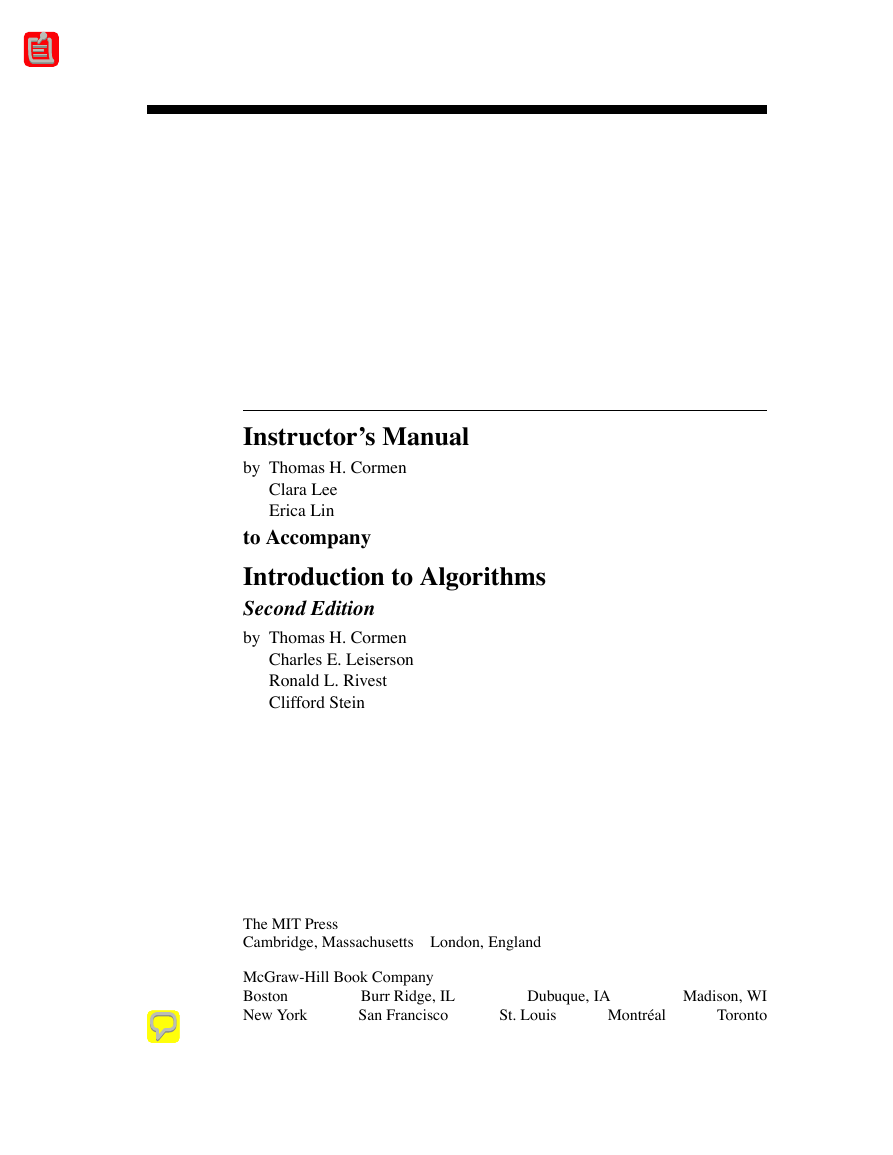
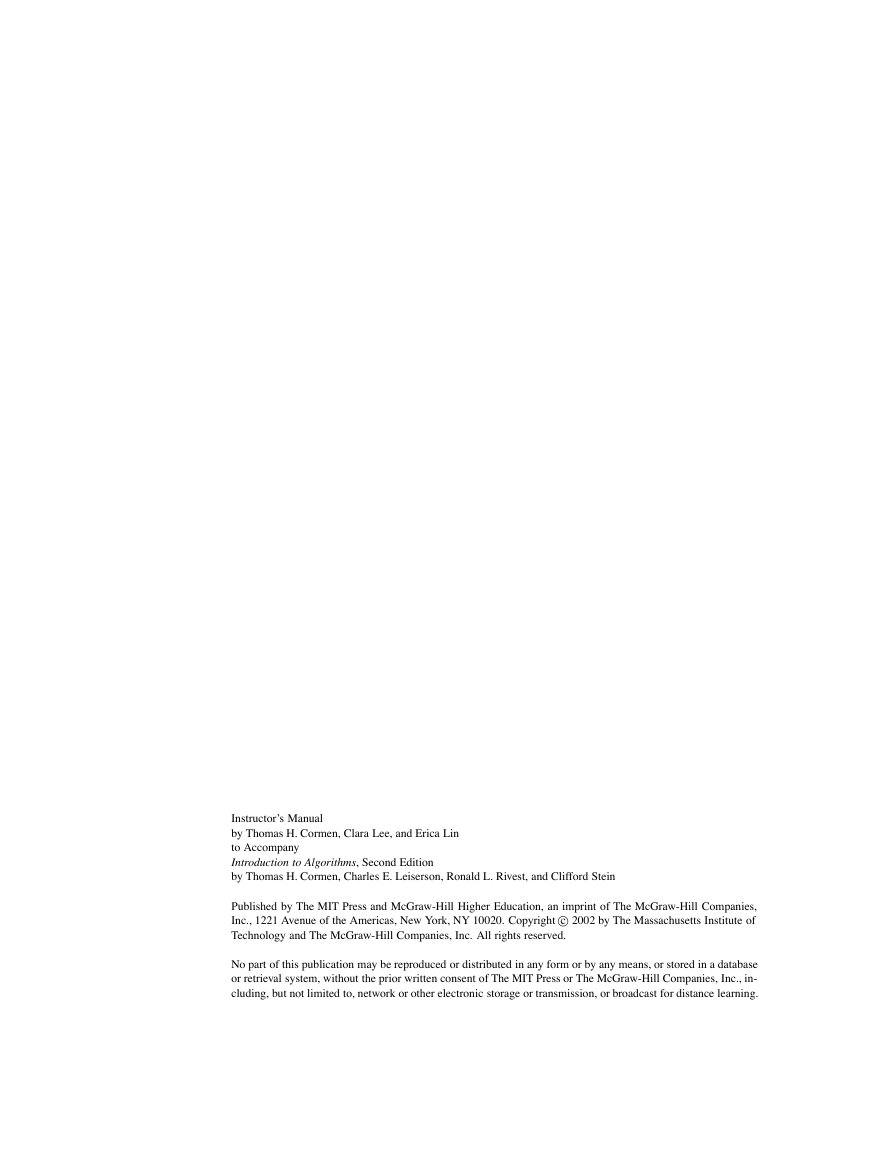
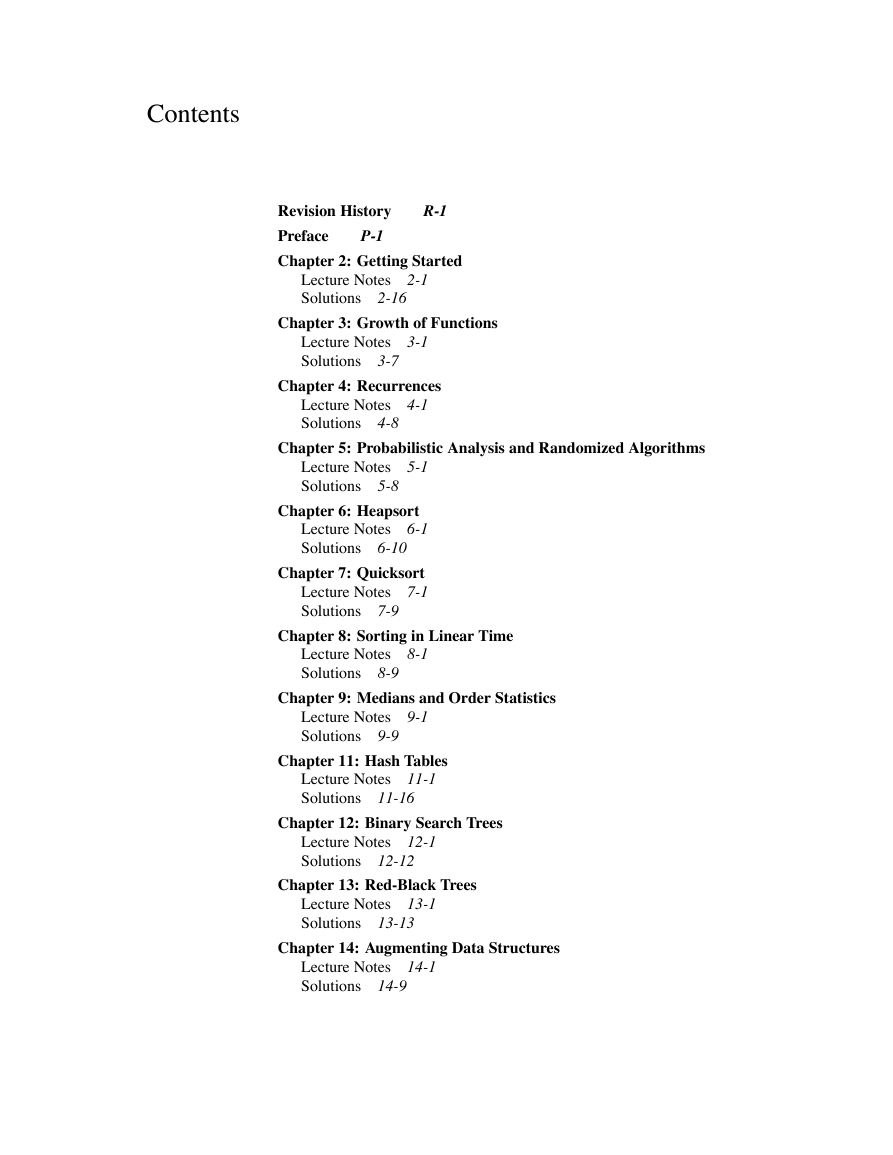
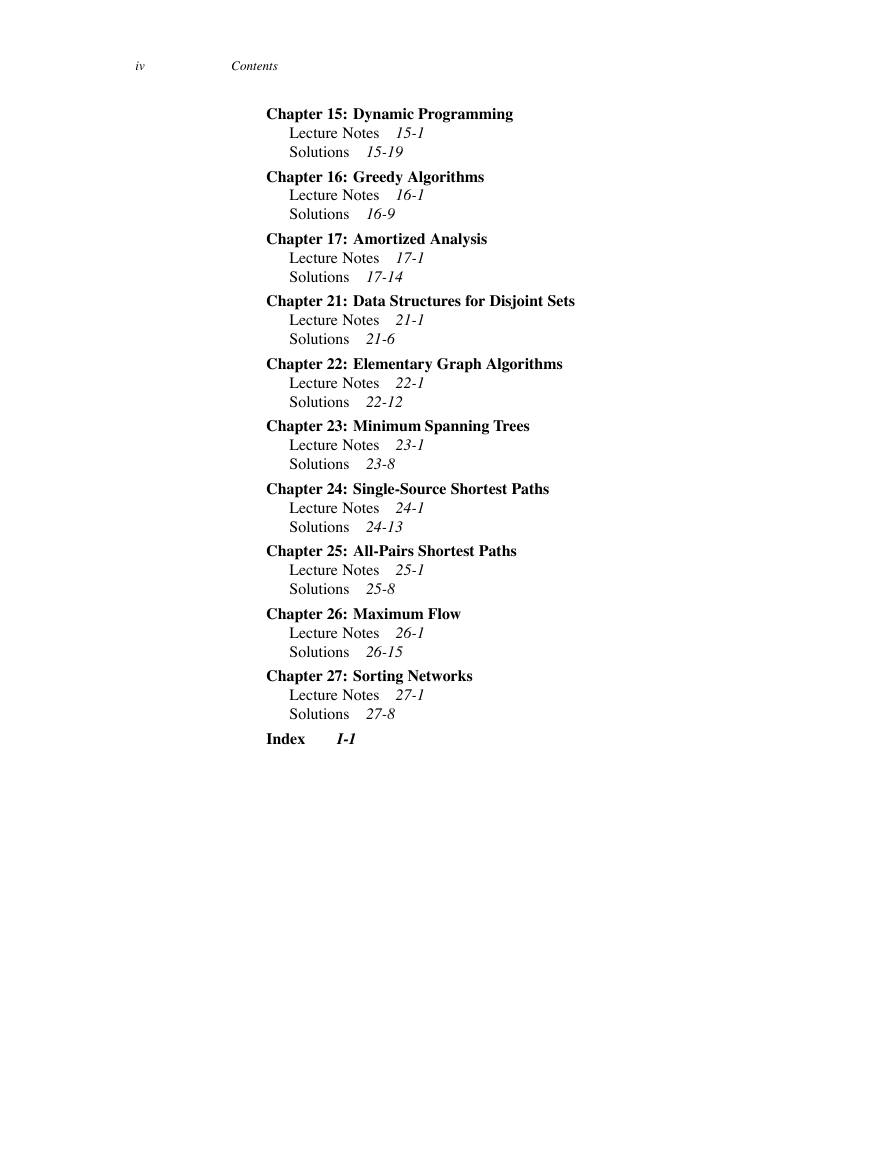
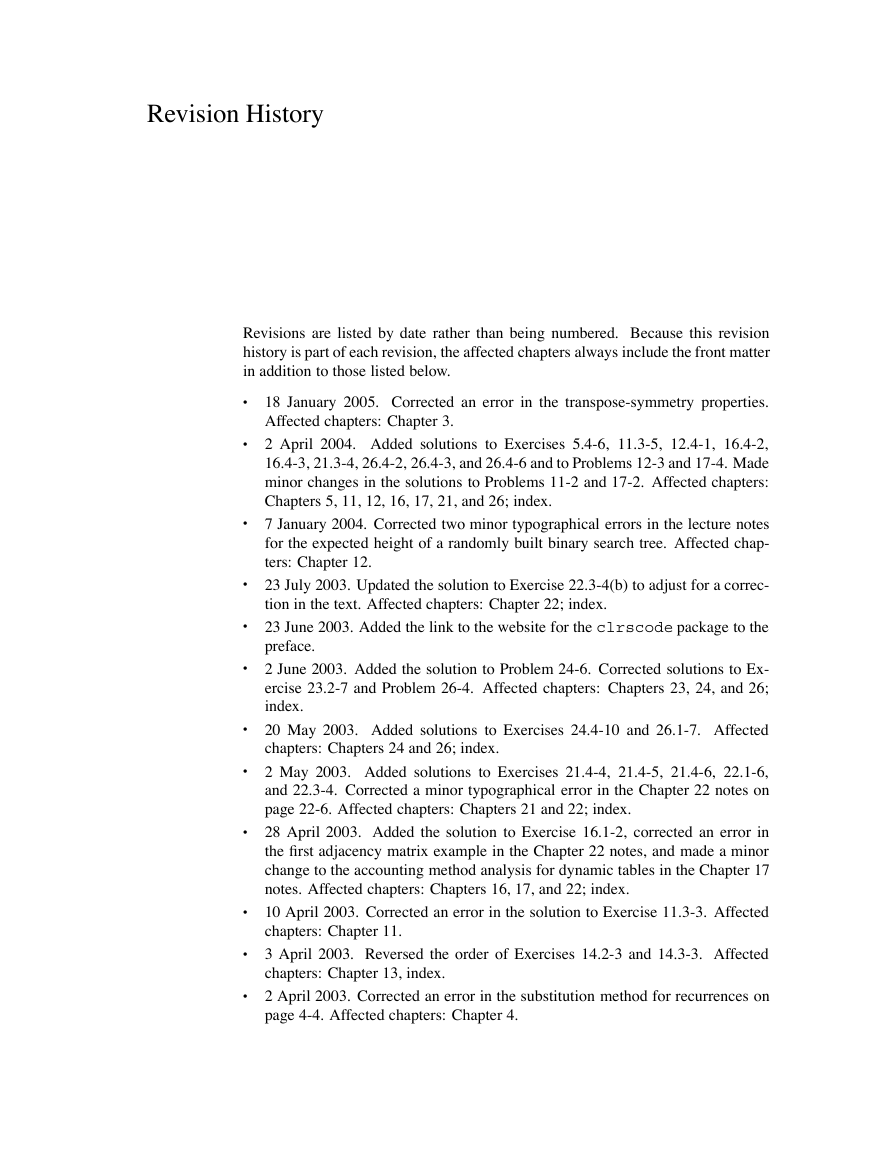
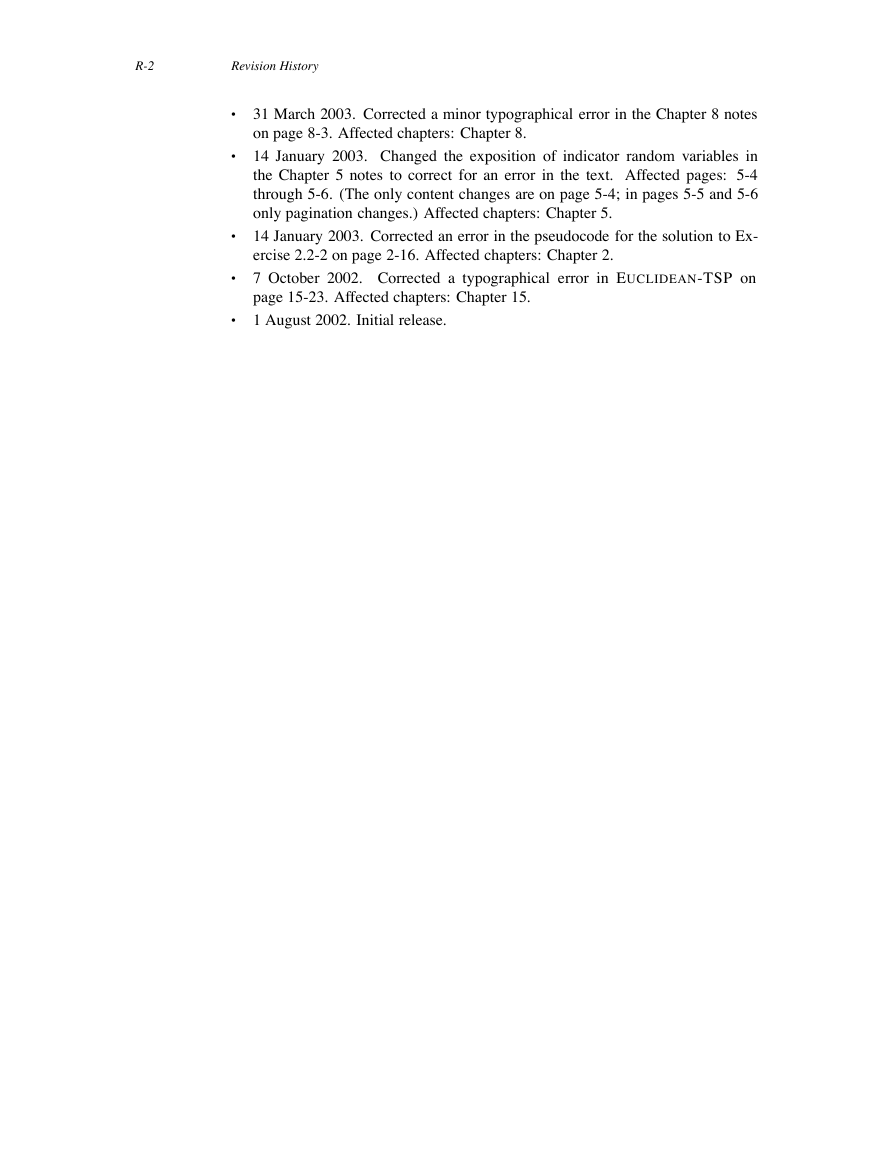
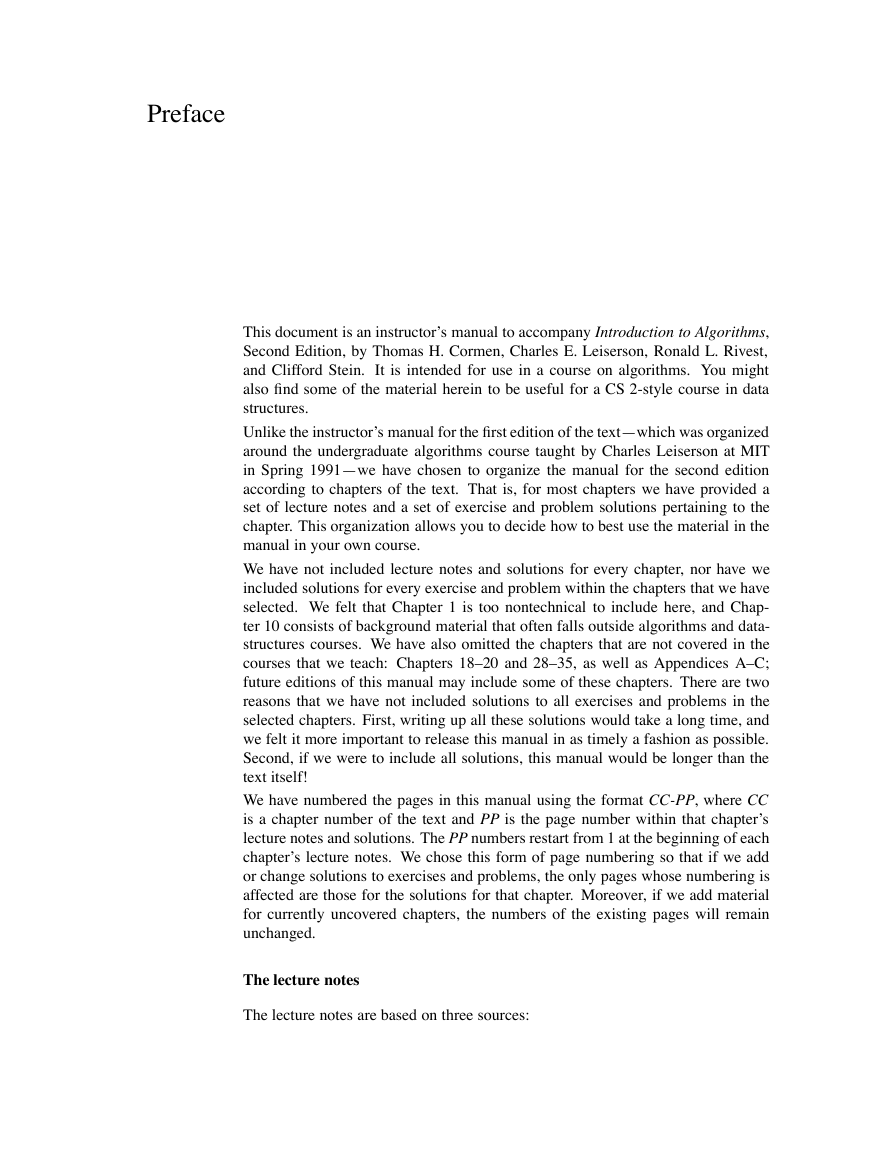
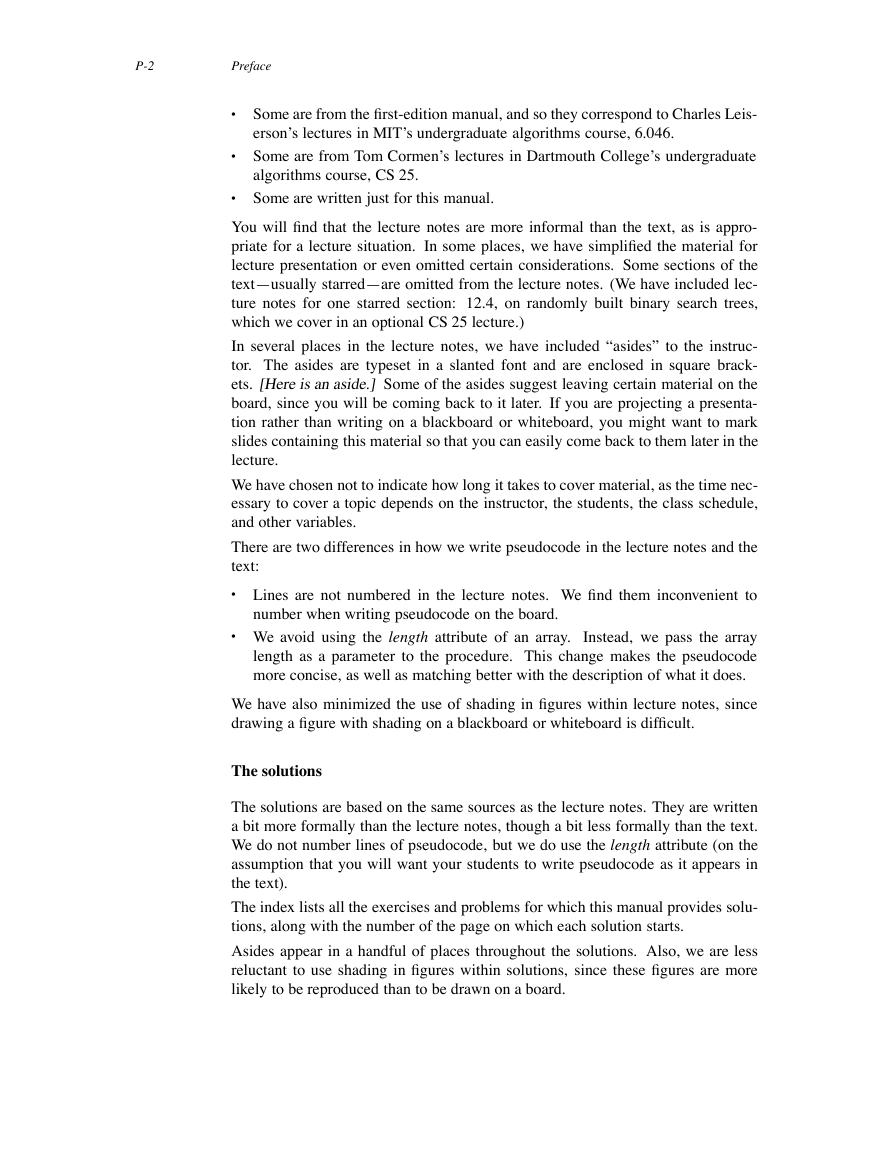








 2023年江西萍乡中考道德与法治真题及答案.doc
2023年江西萍乡中考道德与法治真题及答案.doc 2012年重庆南川中考生物真题及答案.doc
2012年重庆南川中考生物真题及答案.doc 2013年江西师范大学地理学综合及文艺理论基础考研真题.doc
2013年江西师范大学地理学综合及文艺理论基础考研真题.doc 2020年四川甘孜小升初语文真题及答案I卷.doc
2020年四川甘孜小升初语文真题及答案I卷.doc 2020年注册岩土工程师专业基础考试真题及答案.doc
2020年注册岩土工程师专业基础考试真题及答案.doc 2023-2024学年福建省厦门市九年级上学期数学月考试题及答案.doc
2023-2024学年福建省厦门市九年级上学期数学月考试题及答案.doc 2021-2022学年辽宁省沈阳市大东区九年级上学期语文期末试题及答案.doc
2021-2022学年辽宁省沈阳市大东区九年级上学期语文期末试题及答案.doc 2022-2023学年北京东城区初三第一学期物理期末试卷及答案.doc
2022-2023学年北京东城区初三第一学期物理期末试卷及答案.doc 2018上半年江西教师资格初中地理学科知识与教学能力真题及答案.doc
2018上半年江西教师资格初中地理学科知识与教学能力真题及答案.doc 2012年河北国家公务员申论考试真题及答案-省级.doc
2012年河北国家公务员申论考试真题及答案-省级.doc 2020-2021学年江苏省扬州市江都区邵樊片九年级上学期数学第一次质量检测试题及答案.doc
2020-2021学年江苏省扬州市江都区邵樊片九年级上学期数学第一次质量检测试题及答案.doc 2022下半年黑龙江教师资格证中学综合素质真题及答案.doc
2022下半年黑龙江教师资格证中学综合素质真题及答案.doc